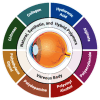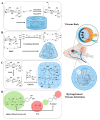Hydrogel-Based Vitreous Substitutes
- PMID: 40943326
- PMCID: PMC12428293
- DOI: 10.3390/ijms26178406
Hydrogel-Based Vitreous Substitutes
Abstract
Hydrogel-based vitreous substitutes have been considered as a potential solution for the treatment of retinal disorders, especially when the natural vitreous body is damaged due to trauma, disease, or surgery. With their high-water content, biocompatibility, and tunable mechanical properties, these hydrogels offer a promising alternative to traditional vitreous substitutes. This review explores the role of polymers and crosslinkers in the development of hydrogel-based substitutes, focusing on how these components contribute to the structure and function of hydrogels. The choice of natural polymers, such as hyaluronic acid and collagen, or synthetic ones, such as polyethylene glycol and polyvinyl alcohol, is crucial to mimic the transparency and flexibility of the vitreous body. Crosslinking methods, including physical, chemical, and enzymatic approaches, help control the gelation process and enhance the mechanical strength of the hydrogel. Furthermore, this review demonstrates how these hydrogels interact with biological tissues, which enhances biocompatibility, cell growth, and tissue repair. This review also discusses the challenges and future directions in improving these hydrogels, particularly in terms of long-term stability, integration with ocular tissues, and appropriate mechanical properties. Overall, hydrogel-based vitreous substitutes have significant potential to improve surgical outcomes and restore vision for patients with vitreous injury.
Keywords: crosslinking strategies; polymeric hydrogel; vitreous substitutes.
Conflict of interest statement
The authors declare no conflicts of interest.
Figures






References
Publication types
MeSH terms
Substances
Grants and funding
LinkOut - more resources
Full Text Sources

